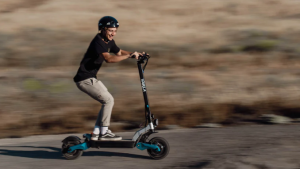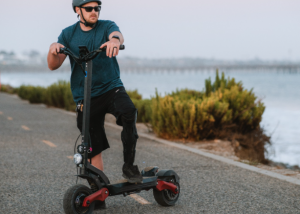Your electric scooter might not reach full speed due to issues like battery health, motor performance, or improper settings.
Troubleshooting Electric Scooter Speed Issues
Battery Health and Charge Level
The health and charge level of the battery are crucial for maintaining the electric scooter’s speed. A fully charged battery should ideally deliver the power needed for the scooter to reach its maximum speed. Batteries with diminished capacity may not provide sufficient voltage, leading to a noticeable reduction in speed. Regularly check the battery voltage using a voltmeter; most electric scooters operate within a range of 24 to 48 volts. Battery replacement is often necessary when capacity falls significantly, which typically occurs after 300-500 charging cycles.
Motor Performance Assessment
The motor is the heart of the electric scooter, directly influencing its speed. Assessing the motor’s performance involves checking for any signs of wear, overheating, or unusual noises. The power rating of the motor, usually measured in watts, determines the scooter’s speed capability. A 250-watt motor is standard for basic models, but higher-end scooters may feature 500 watts or more for increased speed. Regular maintenance, such as cleaning the motor and ensuring its connections are secure, can prevent speed loss.
Checking the Electrical Connections
Loose or corroded electrical connections can impede the flow of power to the motor, thus affecting the scooter’s speed. Inspect all connections, including those at the battery, motor, and control panel. Ensure that connectors are tight and free from corrosion. Corrosion can be cleaned with a solution of baking soda and water, but severely damaged connectors might need replacement.
Firmware and Software Updates
Like many modern devices, electric scooters can benefit from firmware and software updates. These updates can improve the scooter’s efficiency and performance, including its speed. Manufacturers may release updates to fix bugs or enhance functionality. Check the manufacturer’s website or the scooter’s app for available updates. Upgrading the firmware might require connecting the scooter to a computer or using a smartphone app.
Understanding Scooter Mechanics and Electronics
The Role of the Motor in Scooter Speed
The motor is a pivotal component in determining an electric scooter’s speed. Its power, usually measured in watts, can range from 250 watts for basic models to over 1000 watts for high-performance scooters. A higher wattage motor generally delivers more speed. However, greater power can also mean reduced battery life and increased overall cost. The motor’s efficiency, a key factor in its performance, depends on its design and the materials used. Brushless motors, for example, are more efficient and durable but come at a higher cost.
Battery Specifications and Their Impact on Speed
Batteries not only power the motor but also play a significant role in the scooter’s speed. The key specifications include voltage, capacity (measured in ampere-hours, Ah), and the type of battery (like lithium-ion or lead-acid). A higher voltage (typically ranging from 24V to 48V) can boost speed. The battery’s capacity, which might vary from 5Ah to 30Ah or more, affects the scooter’s range. Lithium-ion batteries offer a balance of weight, performance, and lifespan but are more expensive than lead-acid batteries. The battery’s life expectancy is generally around 500-1000 charge cycles.
Importance of Electronic Speed Controllers
Electronic Speed Controllers (ESC) are crucial in managing the scooter’s speed. They regulate the power delivered to the motor, ensuring smooth acceleration and controlling the maximum speed. An efficient ESC optimizes the scooter’s performance and battery usage. The quality and configuration of the ESC can significantly impact the scooter’s responsiveness and top speed. High-quality ESCs can also provide additional features like regenerative braking, further enhancing efficiency.
Maintenance Practices for Optimal Scooter Performance
Regular Cleaning and Inspection
To maintain your electric scooter’s performance, regular cleaning and inspection are essential. Dirt and debris can impede the scooter’s mechanisms, while unnoticed damage can progress into serious issues.
- Inspect the frame for any cracks or damage.
- Check all screws and fastenings for tightness.
- Look for any loose wires or components in the electrical system.
- Clean the scooter with a damp cloth, avoiding water ingress into electrical components.
Tire Maintenance and Pressure Checks
Tires are critical for safe riding and directly affect the scooter’s speed and battery efficiency.
- Regularly check tire pressure; incorrect pressure leads to increased battery consumption and reduced speed. Most scooter tires require a pressure between 40 to 60 PSI.
- Inspect tires for wear and tear; worn-out tires compromise safety and performance.
- Consider tire type: air-filled tires offer a smoother ride but require more maintenance than solid tires.
Lubrication of Moving Parts
Proper lubrication of the scooter’s moving parts reduces friction, which can improve both speed and battery efficiency.
- Lubricate bearings and joints periodically with a suitable lubricant. This not only ensures smooth operation but also prolongs the lifespan of these components.
- Avoid over-lubrication as it can attract dirt and lead to the accumulation of grime.
- Choose the right lubricant: a dry lubricant is often recommended for electric scooters as it doesn’t attract as much dirt as wet lubricants.
Diagnosing Common Speed-Related Problems
Overcoming Reduced Speed Due to Overloading
Excess weight on an electric scooter can significantly reduce its speed. The scooter’s motor has to work harder to move additional weight, which can also drain the battery faster.
- Check the weight limit: Most scooters have a maximum weight capacity, typically ranging from 220 to 300 pounds.
- Reduce load: Carrying less weight can help the scooter regain its optimal speed.
- Upgrade the scooter: If carrying more weight is a necessity, consider a scooter with a higher weight capacity and a more powerful motor.
Resolving Speed Issues Caused by Environmental Factors
Environmental conditions like terrain and weather can impact the scooter’s speed.
- Ride on smooth surfaces: Rough or uneven terrain can slow down the scooter.
- Be cautious in wet conditions: Slippery surfaces reduce traction, causing the scooter to work harder.
- Adjust riding style: Slowing down in challenging environmental conditions can preserve battery life and motor efficiency.
Addressing Wear and Tear Impacts on Speed
Regular use of an electric scooter naturally leads to wear and tear, which can affect its speed over time.
- Regular maintenance: This includes checking and replacing worn-out parts like tires, brakes, and batteries.
- Battery care: Older batteries may not hold charge as effectively, leading to reduced speed. Replacing the battery can often restore performance.
- Professional inspection: If the speed issue persists, a professional check-up can diagnose deeper problems that might not be visible to the untrained eye.
User Control Settings and Adjustments
Understanding Scooter Speed Settings
Electric scooters come with varying speed settings, allowing riders to choose how fast they go. These settings are designed to balance speed with safety and battery efficiency.
- Multiple speed modes: Many scooters offer different modes, such as Eco, Normal, and Sport, each with its own speed cap.
- Speed and battery life: Higher speed settings typically consume battery power more quickly. Eco modes extend battery life by limiting speed.
- Safety considerations: Some regions have legal speed limits for electric scooters, often around 15-20 mph.
Adjusting the Scooter’s Speed Limiter
The speed limiter on an electric scooter is a feature designed to cap the maximum speed for safety and regulatory compliance.
Accessing speed limiter settings: This can usually be done via the scooter’s digital dashboard or a connected smartphone app.
Customization for different needs: Adjusting the speed limiter allows riders to align the scooter’s performance with their skill level and local speed regulations.
Impact on performance: While increasing the speed limit can offer a faster ride, it may also reduce the overall efficiency and lifespan of the scooter’s battery.
Calibrating the Throttle for Better Speed Control
Proper throttle calibration ensures smooth acceleration and better control over the scooter’s speed.
Calibration process: This involves adjusting the throttle’s responsiveness to rider input. It can usually be done through the scooter’s settings menu.
Enhanced riding experience: A well-calibrated throttle provides a smoother ride by preventing jerky starts and stops.
Maintenance: Regular calibration checks are essential, as wear and tear can affect throttle responsiveness over time.


